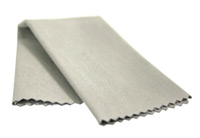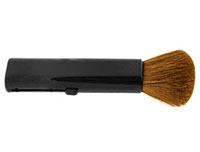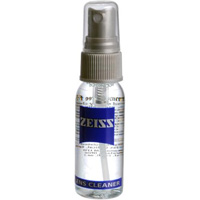Cleaning Cameras and Lenses

Your camera equipment will be delighted if you care for them tenderly and probably it might be nice for you as well if you occasionally clean them from dust, grease stains, and other kinds of dirt that a lens accumulates in your everyday use. There are a lot of ways and means to take to keep your cameras and lenses and especially the front lens in mint condition. This site offers some quick how-to, quide lines, and a video tutorial to keep your camera and camera lens as new and we also tell you which products to use.
Always use a Filter
Using a camera lens filter, specifically a UV or clear protective filter, offers a first line of defense for your valuable lens. It safeguards against the unforeseen scratches, smudges, and minor impacts that could mar the delicate lens surface. While lenses are built to be sturdy, repairs or replacements can be costly and time-consuming. A protective filter, being a fraction of the lens's cost, acts as a sacrificial layer, taking on any damage and preserving the lens's optical quality. Additionally, they can shield against dust, moisture, and fingerprints, further ensuring that your lens remains pristine. Given the unpredictable nature of photography, where quick movements and changing environments are common, having this extra layer of protection offers peace of mind, allowing photographers to focus more on their craft and less on potential equipment mishaps.
Cleaning Kit and Accessories
Whether you have a filter on your lens or not, the methods and accessories used for cleaning are the same and that goes with both lenses and cameras. Here are some products that may be useful to have when you are taking care of your equipment.
 |
Micro Fiber Cleaning ClothThe Micro Fiber Cleaning Cloth, specifically designed for camera lenses, is an essential tool for photographers and videographers. Made from extremely fine synthetic fibers, this cloth effectively captures dust, grime, and oily fingerprints, ensuring a streak-free and scratch-free finish. Its gentle composition makes it safe to use on high-quality lens coatings, providing clarity and maintaining the integrity of the lens. For best results, it's recommended to lightly wipe the lens in a circular motion, starting from the center and moving outwards. Regular use can significantly prolong the lifespan of your lens and improve image quality. |
 |
Lens PenThe Lens Pen is a compact and effective tool tailored for camera lens maintenance, widely cherished by photographers and videographers. On one end, it boasts a soft retractable brush for sweeping away dust particles, while the opposite end features a non-liquid cleaning tip, infused with a carbon compound, to safely and efficiently remove smudges and fingerprints. Designed to avoid damage, the Lens Pen ensures that lens coatings remain unharmed. Its pocket-sized nature makes it perfect for on-the-go cleaning, ensuring that lenses remain pristine and images stay sharp. For optimal results, it's advised to first use the brush to remove loose debris before addressing smudges with the carbon tip. |
 |
AirbrushThe Air Brush, a unique fusion of a brush and an air cushion, is a specialized tool for camera lens care. Its design encompasses soft bristles adept at gently sweeping away particles while the integrated air cushion can be pressed to release a burst of air, efficiently displacing more stubborn dust or debris. This dual action ensures a comprehensive clean, minimizing the risk of scratches or residue. The Air Brush provides an all-in-one solution for photographers and videographers seeking to maintain their lenses in pristine condition, ensuring clear and sharp images. When using, it's beneficial to first deploy the air burst to dislodge larger particles, followed by the brush for finer cleaning. |
 |
Retractable brushThe Retractable Brush is a must-have accessory for meticulous photographers and videographers. Specifically designed for camera lens maintenance, this brush features soft, anti-static bristles that effortlessly sweep away dust, debris, and fine particles without risking any scratch or harm to the delicate lens surface. Its retractable design not only ensures that the bristles remain clean and protected when not in use, but also makes it compact and travel-friendly. By extending the brush, users can confidently clean even the nooks and corners of their lenses. For optimal lens care, always retract the brush after use to prevent contamination, ensuring it's ready for the next cleaning session. |
 |
Rocket Air / Air Blower / Rocket BlowerKnown by various names such as "Rocket Air," "Air Blower" and "Rocket Blower" this indispensable tool is a favorite among photography enthusiasts for camera lens maintenance. The Rocket Air is specifically designed to release controlled bursts of air, effectively displacing dust, debris, and fine particles from the lens without making direct contact. This ensures that the delicate lens surface remains free from scratches and smudges. Its distinctive rocket-like shape not only provides an ergonomic grip but also prevents the blower from rolling on flat surfaces. For maintaining optimal image clarity and safeguarding the lens's longevity, the Rocket Air is an essential inclusion in any photographer's toolkit. |
 |
Cotton swabsCotton swabs, commonly associated with personal care, have found their niche in the world of photography as a precise tool for camera lens cleaning. Featuring a slender stick with soft cotton tips on either end, these swabs are perfect for reaching into the tight corners and edges of a lens, ensuring thorough removal of dust, smudges, or oily residues. When paired with a suitable lens cleaning solution, cotton swabs can effectively address stubborn spots without risking any harm to the delicate lens coatings. For photographers keen on maintaining their equipment in impeccable condition, cotton swabs offer a simple yet effective means of achieving a spotless lens surface. |
 |
Lens Cleaning solutionThe "Lens Cleaning Solution" is a specialized liquid, often housed in a small spray bottle, tailored for the meticulous care of camera lenses. Crafted to safely dissolve grease, fingerprints, and smudges, this solution ensures a streak-free and clear lens surface, pivotal for capturing crisp images. Unlike generic cleaning agents, the Lens Cleaning Solution is formulated to be gentle, ensuring that it won't harm the delicate coatings and optical elements of camera lenses. For optimal results, it's often sprayed onto a microfiber cloth or a cotton swab, rather than directly onto the lens, to prevent over-saturation and potential residue. An indispensable asset for every photographer, this solution ensures lenses remain in pristine condition, enhancing their longevity and performance. |
Cleaning Kit - All in one
There are many good and affordable packages that gather some of the above accessories.
Cleaning Your Camera Lenses
- Eliminate loose dust and debris using the Rocket Air Blower, a crucial tool for lens maintenance.
- With a high-quality Lens Cleaning Brush, delicately sweep away residual particles to ensure the lens surface is free from contaminants.
- Moisten a Micro Fiber Cleaning Cloth with the specially formulated Lens Cleaning Solution, then gently wipe the lens in a circular pattern to remove smudges, fingerprints, and oily residues.
Instruction video
Do not clean your lens too often
A mistake often made is using the Micro Fiber Cloth before you blow away dust and dirt, which can result in dragging around dust particles and scratching the lens. The fact that a lens and the front lens get a little dusty at times is normal, it is difficult to avoid but do not clean the lens too often (and do not use alcohol, etc) since perpetual rubbing and cleaning can damage the lens and its surface treatment (coating).
Be careful when changing lenses
When changing lenses (to clean the backside of the lens, as seen in the video above) you open up and expose the inside of the camera. The camera will then be open for dust particles to enter and in case the sensor of the camera is affected by dirt and stains, this can have visible impacts and effects on the image and any dirt on the sensor can be difficult and tricky to remove without consulting a camera repair shop. Because of this, it is important that whenever you change a lens, try to be as quick as possible and to the greatest extent possible, do not change lenses in dusty environments.
Cleaning Your DSLR or Mirrorless Camera
Maintaining a clean DSLR or mirrorless camera is crucial for ensuring optimum image quality and the longevity of your equipment. Regular cleaning can prevent dust, smudges, and other contaminants from affecting your photographs and protect your investment. This guide provides step-by-step advice on keeping your camera in pristine condition.
1. Cleaning the Exterior
Tools Needed: Soft brush, microfiber cloth, isopropyl alcohol (optional).
Gently brush away dirt and dust from the camera body, focusing especially on the crevices, buttons, and dials. For smudges or sticky residues, lightly dampen a microfiber cloth with a mixture of isopropyl alcohol and water and wipe the camera's surface. Always ensure the camera is turned off and batteries are removed before cleaning.
2. Cleaning the Sensor
Tools Needed: Rocket Air Blower, sensor cleaning kit (if necessary).
For DSLRs, lock up the mirror first. With the camera facing down to minimize further dust entry, use the Rocket Air Blower to gently blow away dust from the sensor. If stubborn spots remain, consider using a dedicated sensor cleaning kit or seeking professional assistance.
3. Cleaning the Lens Mount
Tools Needed: Soft brush, Rocket Air Blower.
Remove the lens from the camera body. Use the brush to gently sweep away dust from the lens mount on both the camera and lens. Complement this with the Rocket Air Blower for a thorough clean. Avoid using any liquid cleaners here, as they can seep into the camera internals.
4. Cleaning the Viewfinder and LCD Screen
Tools Needed: Microfiber cloth, lens cleaning solution.
Wipe away fingerprints and smudges from the viewfinder and LCD using a microfiber cloth. For stubborn marks, apply a small amount of lens cleaning solution to the cloth and gently wipe the surfaces.
5. Cleaning the Memory Card and Battery Slots
Tools Needed: Rocket Air Blower, soft brush.
With the battery and memory card removed, gently blow air into the compartments to remove dust. A soft brush can help dislodge any particles in tighter spaces. Ensure both compartments are dry and free of debris before reinserting the battery or memory card.
Preventive Measures
Prevention is always better than cure. Always store your camera in a protective bag when not in use. Avoid changing lenses in dusty environments and always power off the camera before doing so. Using lens caps and camera covers can further shield your equipment from potential contaminants.
Remember, while routine cleaning can be done at home, it's essential to consult professionals for more intensive cleaning or if you're unsure about any procedures. Regular maintenance will ensure your DSLR or mirrorless camera serves you well for years to come.
Handling Dust in Your Camera and Lens
Whether you're a seasoned professional or an enthusiastic amateur, keeping your camera and lens free from dust is paramount. Dust particles can compromise image quality, making maintenance an essential part of a photographer's routine. This guide offers insights into effectively managing and preventing dust-related issues with your gear.
Dust on the Camera Sensor
Symptoms
Dust on the camera sensor typically appears as small, dark spots on your images, most evident when shooting plain backgrounds like the sky with a small aperture (e.g., f/22).
Solution
- Use the camera's built-in sensor cleaning function if available.
- Use a Rocket Air Blower: Remove the lens, hold the camera with the lens mount facing downwards, and blow air onto the sensor.
- If the dust remains, you might consider purchasing a sensor cleaning kit with swabs and a liquid cleaner specifically for sensors.
- For persistent issues or if you're unsure, it's advisable to take your camera to professionals for a sensor cleaning service.
Dust Inside the Lens
Symptoms
While a few specks of dust inside a lens generally won't affect your image quality, excessive dust or larger particles might.
Solution:
- Avoid disassembling the lens on your own, as lenses are precisely calibrated, and any mistakes can lead to focus issues.
- Use a Rocket Air Blower, blowing air into the lens and adjusting the focal lengths (for zoom lenses) to potentially dislodge any dust particles.
- If the problem persists, it's best to consult with a professional lens repair service to have the lens cleaned internally.
Prevention
Preventive measures can minimize the risk of dust infiltration:
- Always power off the camera before changing lenses, as some cameras can generate a static charge when on, which may attract dust.
- Change lenses swiftly and in areas with minimal dust.
- Store your camera gear in sealed camera bags to reduce exposure to dust.
- Always use body caps and rear lens caps when you're storing your camera body and lenses separately.
Remember, while dust can be an inconvenience, it's a common issue for photographers. Regular maintenance and careful handling of your gear can help keep it at bay, but occasionally, professional cleaning might be necessary for optimal equipment performance.